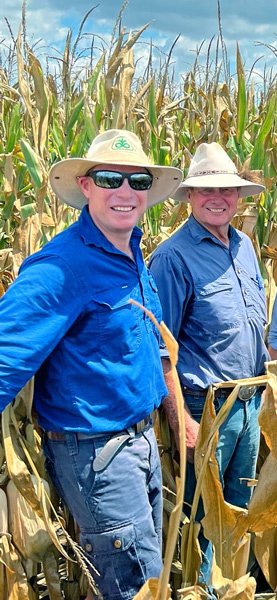Smart cotton growers sock their next rotation
It takes about 230 kg of ginned cotton to make about 215 pairs of jeans or 4300 pairs of socks. If you’re a cotton grower, however, there’s more than fashion at stake when it comes time to selecting a rotation crop.
 Aside from the perennial considerations of pests, weeds, and water, cotton growers are increasingly moving towards corn as a rotation because it helps reduce the incidence of verticillium wilt (Verticillium dahlia), a soil-borne fungus that enters the roots and gets into the vascular system of the cotton plant.
Aside from the perennial considerations of pests, weeds, and water, cotton growers are increasingly moving towards corn as a rotation because it helps reduce the incidence of verticillium wilt (Verticillium dahlia), a soil-borne fungus that enters the roots and gets into the vascular system of the cotton plant.
Rotating corn into cotton production systems is a well-recognised practice, but few are doing at the scale of North Star grower Will Coulton.
His large-scale enterprise in northern NSW focuses on cotton but for several years he’s been concerned at the incidence of verticillium wilt.
“Last year, we had quite a good season and quite a bit of water,” he said.
“It was a good opportunity to put out a large area of corn to take advantage of on-farm water that was otherwise going to evaporate – and reduce verticillium in the soil.”
Periods of cooler, overcast and wet weather are known to herald outbreaks of verticillium wilt.
From a planting of 900 hectares (2223 acres) Mr Coulton's Pioneer P1756 corn returned 12.6 tonne/hectare average.
“During planting, we had a bit of trouble with the fertiliser spreader in a few of the paddocks, and the corn that emerged was like chalk-n-cheese,” he said.
Where the spreader failed to do its job properly, yield dropped to about 9 tonne/hectare.
However, in areas that received the correct fertiliser application, yields were noticeably better at about 15–16 tonne hectare.
“If you feed the corn, it definitely helps you,” he said.
“The water-use is similar to cotton, and so is the fertiliser.”
For cotton growers combatting verticillium wilt, corn is an ideal rotation as the crop’s earlier planting normally means is does not have to compete with cotton for water.
Another big advantage, Mr Coulton said, were the practical benefits presented by the timing of the corn harvest.
When harvesting finishes in January, it allows a window of several weeks before cotton picking starts about February–March.
Harvest logistics
But the logistics of harvesting Mr Coulton’s North Star corn crop are just as impressive as his irrigated corn yield.
With a header bringing in 1000 tonnes of a day, his 8000 tonnes of on-farm storage played a key role in keeping 12 road trains busy transporting corn kernels to the grain handler.
In a 2017 scientific study conducted at North Star, it was noted that the incidence of verticillium wilt prior to harvest was greater where ‘cotton was planted after cotton’ and least where cotton was followed by ‘one crop of sorghum or corn’.
Pioneer sales manager Ben Thrift said cotton growers liked rotating corn into cotton because it’s relatively easy to remove broadleaf weeds out of the crop.
“Another benefit is that cotton tends to do well after corn and corn does well after cotton – a win-win planting strategy,” Mr Thrift said.
“I’d say for those thinking of planting cotton-on-cotton or moving away from planting legumes, it’s time to select a high-performing corn or sorghum – which both offer considerable advantages in rotation.
“Whether you’re looking for ‘even tillering’ with a great yield or an honest hybrid that’ll finish the year like a champion despite some testing conditions, there’s a corn or sorghum variety that’s ideally suited for your requirement.”
For even greater reassurance, Mr Thrift said, growers should ensure next bag of seed they buy includes all the latest pre-planting technologies that promote efficacy and maximise returns.
“Of course, if you’re thinking of moving into corn, you’ll need to keep good records and check your labels for plant-back periods.”
“Once the decision is made, growers have the assurance of knowing they’ll get the best out of their next rotation.”
Then they can get on with the business of growing the world-class cotton … and we can all enjoy the soft natural feeling of cotton socks for years to come.
Photo: Ben Coulton, Will's father, (right) inspects the P1756 corn rotation with Pioneer Territory Sales Manager Ben Thrift.
